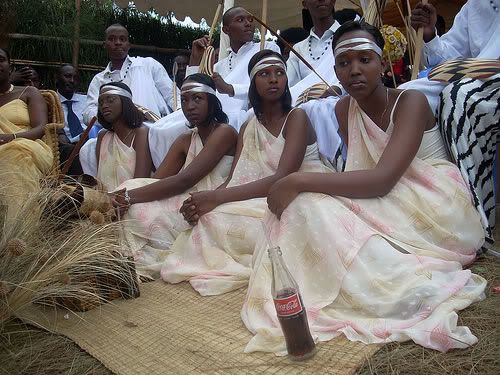
Ethnically, Rwanda consists of the Tutsi, Hutu and Twa tribes that partly determine the social status of and individual. Its because of the constant conflict between the three tribes, primarily between the Hutu and Tutsi, that shape virtually every aspect of Rwandan culture, economy, and government. The genesis of the conflict between the Tutsi and Hutu tribes began when the German and Belgian governments intervened in the monarchy of Rwanda, reforming it for according to European
tradition .In the process of this reformation, the Germans and Belgians favored the Tutsis, claiming that they were born leaders and should single-handedly run the entire country, so the control of Rwanda shifted in favor of the Tutsi tribe. This upset the Hutu tribe because they originally had the most power and control in running the country. In the 1950s, Hutu ethno-nationalists rioted throughout the country forcing many Tutsi chiefs to flee the country in fear of exile and murder of their family. Tutsi people killed hundreds Hutu population and exiled several more, shifting the administration of the country through the feared influence of the Hutu people again. For forty years the Hutu people remained exiled, primarily in Uganda, and accumulated an army to march back to their home country and regain dominion. The group of Tutsi refugees that invaded, ultimately starting the infamous Rwandan genocide, was known as the Rwanda Patriotic Front and they fought the government to allow the Tutsi refugees back into the country. Thousands of Tutsi and Hutu people were killed in the 1994 genocide but fundamentally the invasion was successful and the Tutsi established themselves as the government again. Presently, they promote a multi ethnic idea of Rwandan national identity, though violence between the Hutu and Tutsi tribes continues. When the photo was taken in 1996, Rwanda invaded Congo to eliminate any threat from rising Rwandan militia who were reorganizing in refugee camps.
Family life in Rwanda is typically patrilocal, the father's side of the family lives together, living together in plots of land called hills. In Rwandan culture, children are a sign of wealth therefore Rwanda has the highest rate fecundity; due to this families rarely have enough money to pay for elementary education of their children, rather they are set to manual labor on farm plots. Daily clothes for a Rwandan individual is of western fashion, such as jean and a tee shirt since most of the population cannot afford traditional clothes or are worn on rare occasions, primarily weddings. Rwanda is an agrarian country, though most have moved to the city after the genocide, so a majority of farmers depend upon their crops and concentrate most of their time tending to their crops.
After researching Rwanda and its culture, the clothes that the girl is wearing in the picture are peculiar in that they don't seem to the normal garb or traditional clothes, but they appear to be expensive enough to assume that she comes from a family with more money than most. The village in the background could possibly be a single family complex; if it were the girls family then it would another sign of her family's wealth with a large family plot of land and genetic line. If these inferences were true, then the girl probably has been educated more than the average child in Rwanda since her family is wealthier than most. The bundle on top of her head turns into the equivalent of a backpack and she returns home to help with the farm.
Works Cited
"Aftermath of Rwandan Genocide." Trincoll, Web. 17 Feb 2010. .
Longman, Timothy. "Rwanda." Countries and their Culture. 2010. Advameg Inc, Web. 17 Feb 2010. .

